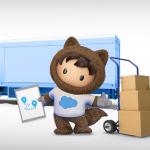Make Every Marketing Moment Matter
‘Moment marketing’ is serving customers the content they need when they are looking for it.
Businesses of all sizes and in all industries can take advantage of moment marketing. It’s not just product-based businesses that can benefit.
At Salesforce World Tour London, we spoke to Marek Borowik, Head of Customer Marketing, and Matt Kemp, CRM & Customer Operations Manager, at Formula 1. They explained how Formula 1 uses data to create marketing moments in three areas: race promotions and hospitality, media rights, and sponsorship.
Find out how your business can increase revenue by ensuring that every marketing moment matters.
Understanding customer journeys to serve the right moments
To make marketing moments matter, you must first understand the customer journey.
If a business doesn’t know how customers are interacting with them, it cannot improve interactions. And if a company doesn’t know which touchpoints its customers are using, it’s impossible to optimise those too.
Businesses can understand these elements by creating a customer journey map. This typically details how customers go from discovery to purchase — covering customers’ motivations, obstacles, and more. The outcome is to know when, where, and how to target your customers.
However, problems can arise when there are many customer journeys and buyer personas. It can be confusing and time-consuming to make sense of data in marketing across millions of customers and touchpoints, plus multiple channels.
That’s why many businesses — including Formula 1 — are not always as aware of their customer journeys as they could be.
Formula 1 has a cumulative audience of 1.5 billion. As Matt explains, there was a lot of data, but none of it was speaking to each other: “There was a lot of research to suggest we had over 500 million fans globally, but no idea who a single one of them were.” That has since changed thanks to data aggregation.
Using data aggregation to better understand potential marketing moments
When Formula 1 went through its digital transformation process, the team realised they were collecting a significant amount of data.
Much of this was customer data, including audience segments, how long they’d been fans, and how they consumed the sport. It also included information about the sport, such as live timing — over a million data points that tell people exactly what’s happening in any race at any time.
Formula 1 needed data aggregation — the process of using automation to collect, process, and present data. And they needed the right tools to make this possible.
With the help of Salesforce, Formula 1 gained a 360-degree view of each customer and their data in one place.
Great marketing moments require data to be aggregated in a timely manner. If marketing moments pass because data is not yet aggregated, then these moments — and the opportunities from them — are missed. You need to be able to meet customers at the right place at the right time.
Make Every Marketing Moment Drive Engagement and Revenue.
Discover more on how Formula 1 is attracting new fans, deepening engagement, and driving revenue with Salesforce. Watch our on-demand World Tour London episode: Make Every Marketing Moment Drive Engagement and Revenue



Ability to meet customers where they are
By understanding the customer and their journey, businesses can meet them right where they are.
Data can help you understand the type of customers that land on which touchpoint or platform and when. This helps you understand the best content to serve users on precise channels. An automated platform can bring all this information into one central depository in real time so that no marketing moments are missed.
Marek explains how, at Formula 1, the lack of full visibility into their fan journey was preventing them from serving the right customers the right content at the right time. But now, with built-out user case journeys, they can curate experiences for their fans.
Next best action
It’s not just about serving customers the best content at a certain time. Data also helps you understand the next best action in the journey.
Once customers have consumed the content that has been served, where do they go next? And can this be collated into a revenue stream?
Formula 1 used its new understanding to educate, nurture, and monetise each customer relationship. For Formula 1, the next best action was revenue-generating sponsorship.
“It’s also about making sure we are giving sponsors and partners the right exposure to the right type of fan in the right area”, Marek says.
Personalised customer connections
We can understand who a customer is by using their individual data or looking at data from similar consumers. We can then use it to inform how we create personalised connections across the customer journey. For example, we can direct them towards the content we know they want to engage with.
Formula 1 previously took much longer when creating personalised customer connections. Sifting through the data could take up to 24 hours. By this time, the marketing moment had often passed. They had data from millions of fans coming onto their front-end properties week after week, race after race, but they couldn’t analyse their data quickly enough.
But that has changed. Matt says that thanks to working with Salesforce, “We’re in a great position now where we can finally get a solution where all of our data comes into a central depository. It’s all stitched together in real-time.” With this, Formula 1 can create deeper customer connections at a fast pace with content that can convert.
Make Every Marketing Moment Drive Engagement and Revenue.
Discover more on how Formula 1 is attracting new fans, deepening engagement, and driving revenue with Salesforce. Watch our on-demand World Tour London episode: Make Every Marketing Moment Drive Engagement and Revenue



























